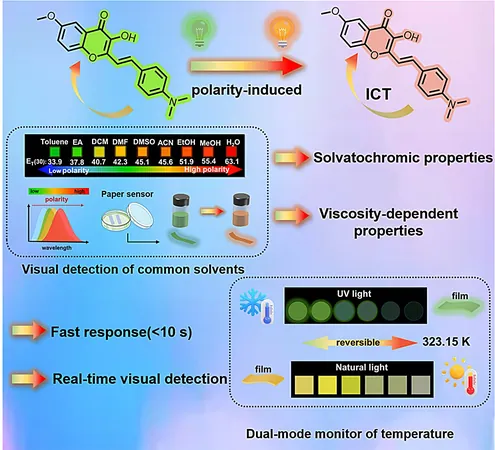
Revolutionary Fluorescent Materials Unveiled: Monitor Solvents and Temperature in Real-Time!
2024-11-22
Author: Noah
Groundbreaking Breakthrough in Fluorescence Technology
A groundbreaking breakthrough in fluorescence technology has emerged from the Hefei Institutes of Physical Science (HFIPS) under the leadership of Professor Jiang Changlong. The innovative research team's latest creation, a novel donor-acceptor (D-A) type fluorescent dye named AFL, is set to revolutionize the way we visualize multi-component solvents and temperature changes.
Unique Properties of AFL
Published in the prestigious journal Advanced Functional Materials, this study sheds light on the unique properties of AFL, which dramatically alters its fluorescence color and intensity based on the polarity of solvents and ambient temperature. This remarkable feature allows for rapid and efficient visual monitoring—a significant advancement over traditional methods.
Challenges Overcome by AFL
D-A fluorescent dyes have long been pivotal in sensor technology due to their ability to detect specific molecules or shifts in environmental conditions. However, many existing D-A dyes struggle with issues like fluorescence quenching, which can compromise their effectiveness in real-world applications.
The AFL@TA Composite Material
The newly developed AFL overcomes these challenges by demonstrating pronounced fluorescence responses aligned with solvent polarity. In highly polar environments, the AFL dye's emission spectrum experiences a noticeable shift, enabling precise solvent polarity detection.
Durability and Flexibility of AFL@TA
Taking it a step further, the research team engineered a composite material known as AFL@TA, achieved by synergistically pairing AFL with tetradecanoic acid (TA). This composite material exhibits variable fluorescence intensity in relation to temperature and viscosity changes. Notably, as temperature escalates, viscosity diminishes, resulting in a corresponding decrease in fluorescence intensity.
Applications in Real-Time Temperature Monitoring
The AFL@TA composite films boast durability and flexibility, potentially paving the way for applications as cutting-edge temperature sensors. Their ability to display a clearly defined linear correlation between temperature and fluorescence intensity equips them to serve as reliable instruments for real-time temperature monitoring across various scenarios.
Broader Implications for Sensing Technology
This research not only broadens the scope of D-A fluorescent sensing materials but also unlocks exciting new avenues for their application in visual sensing technology, from environmental monitoring to industrial processes and beyond. The implications of these findings could very well enhance our ability to address complex challenges in science and industry.
Conclusion
Stay tuned as we continue to follow the trail of this remarkable advancement—could this be the future of real-time sensing technology?



 Brasil (PT)
Brasil (PT)
 Canada (EN)
Canada (EN)
 Chile (ES)
Chile (ES)
 Česko (CS)
Česko (CS)
 대한민국 (KO)
대한민국 (KO)
 España (ES)
España (ES)
 France (FR)
France (FR)
 Hong Kong (EN)
Hong Kong (EN)
 Italia (IT)
Italia (IT)
 日本 (JA)
日本 (JA)
 Magyarország (HU)
Magyarország (HU)
 Norge (NO)
Norge (NO)
 Polska (PL)
Polska (PL)
 Schweiz (DE)
Schweiz (DE)
 Singapore (EN)
Singapore (EN)
 Sverige (SV)
Sverige (SV)
 Suomi (FI)
Suomi (FI)
 Türkiye (TR)
Türkiye (TR)
 الإمارات العربية المتحدة (AR)
الإمارات العربية المتحدة (AR)